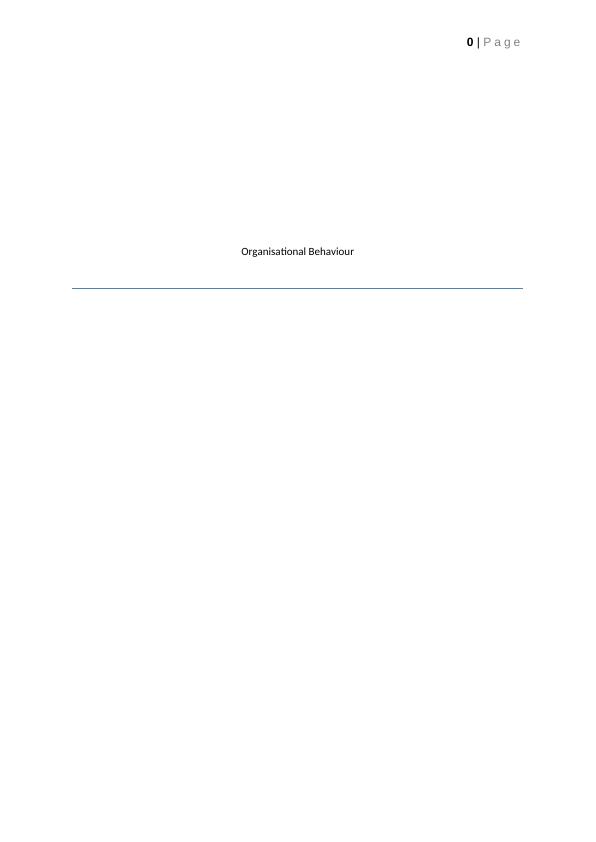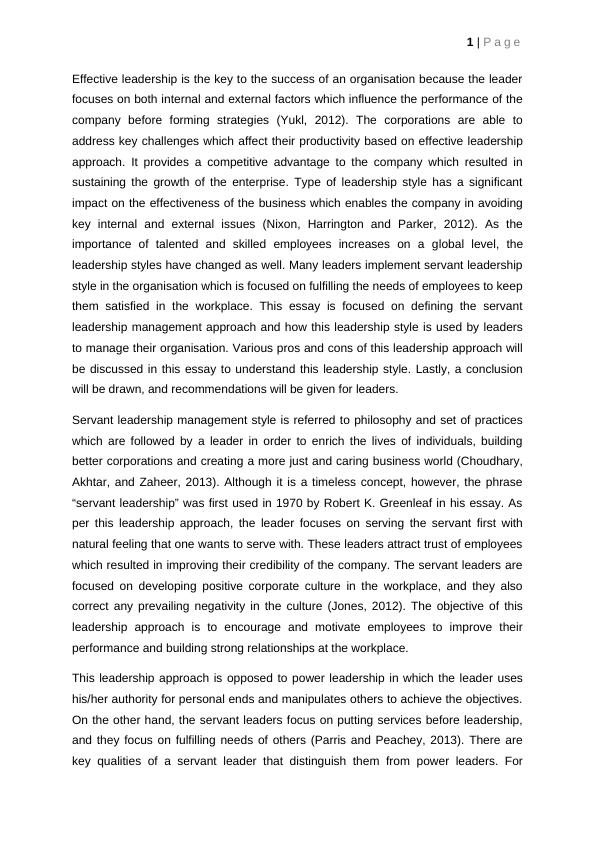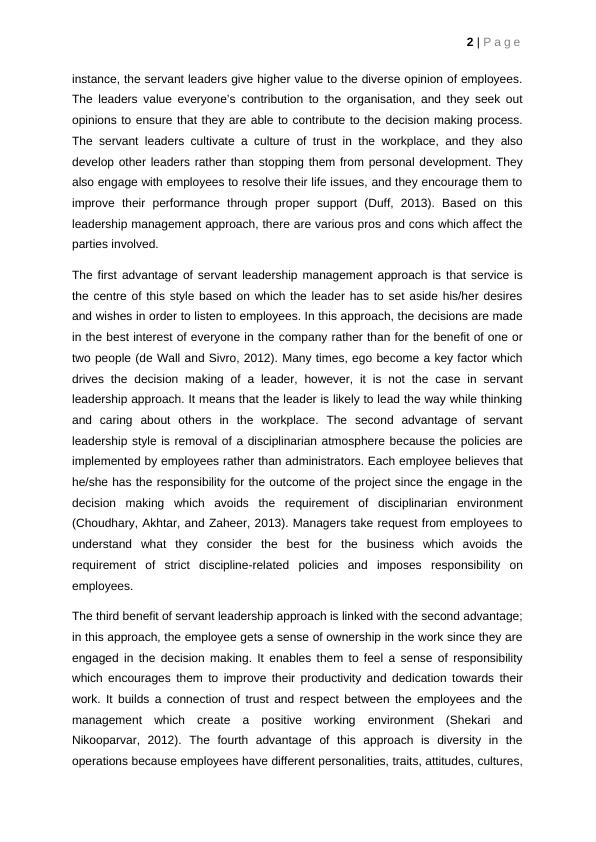Servant Leadership Management Approach: Pros and Cons
Added on 2023-05-29
7 Pages2137 Words494 Views
0 | P a g e
Organisational Behaviour
Organisational Behaviour

1 | P a g e
Effective leadership is the key to the success of an organisation because the leader
focuses on both internal and external factors which influence the performance of the
company before forming strategies (Yukl, 2012). The corporations are able to
address key challenges which affect their productivity based on effective leadership
approach. It provides a competitive advantage to the company which resulted in
sustaining the growth of the enterprise. Type of leadership style has a significant
impact on the effectiveness of the business which enables the company in avoiding
key internal and external issues (Nixon, Harrington and Parker, 2012). As the
importance of talented and skilled employees increases on a global level, the
leadership styles have changed as well. Many leaders implement servant leadership
style in the organisation which is focused on fulfilling the needs of employees to keep
them satisfied in the workplace. This essay is focused on defining the servant
leadership management approach and how this leadership style is used by leaders
to manage their organisation. Various pros and cons of this leadership approach will
be discussed in this essay to understand this leadership style. Lastly, a conclusion
will be drawn, and recommendations will be given for leaders.
Servant leadership management style is referred to philosophy and set of practices
which are followed by a leader in order to enrich the lives of individuals, building
better corporations and creating a more just and caring business world (Choudhary,
Akhtar, and Zaheer, 2013). Although it is a timeless concept, however, the phrase
“servant leadership” was first used in 1970 by Robert K. Greenleaf in his essay. As
per this leadership approach, the leader focuses on serving the servant first with
natural feeling that one wants to serve with. These leaders attract trust of employees
which resulted in improving their credibility of the company. The servant leaders are
focused on developing positive corporate culture in the workplace, and they also
correct any prevailing negativity in the culture (Jones, 2012). The objective of this
leadership approach is to encourage and motivate employees to improve their
performance and building strong relationships at the workplace.
This leadership approach is opposed to power leadership in which the leader uses
his/her authority for personal ends and manipulates others to achieve the objectives.
On the other hand, the servant leaders focus on putting services before leadership,
and they focus on fulfilling needs of others (Parris and Peachey, 2013). There are
key qualities of a servant leader that distinguish them from power leaders. For
Effective leadership is the key to the success of an organisation because the leader
focuses on both internal and external factors which influence the performance of the
company before forming strategies (Yukl, 2012). The corporations are able to
address key challenges which affect their productivity based on effective leadership
approach. It provides a competitive advantage to the company which resulted in
sustaining the growth of the enterprise. Type of leadership style has a significant
impact on the effectiveness of the business which enables the company in avoiding
key internal and external issues (Nixon, Harrington and Parker, 2012). As the
importance of talented and skilled employees increases on a global level, the
leadership styles have changed as well. Many leaders implement servant leadership
style in the organisation which is focused on fulfilling the needs of employees to keep
them satisfied in the workplace. This essay is focused on defining the servant
leadership management approach and how this leadership style is used by leaders
to manage their organisation. Various pros and cons of this leadership approach will
be discussed in this essay to understand this leadership style. Lastly, a conclusion
will be drawn, and recommendations will be given for leaders.
Servant leadership management style is referred to philosophy and set of practices
which are followed by a leader in order to enrich the lives of individuals, building
better corporations and creating a more just and caring business world (Choudhary,
Akhtar, and Zaheer, 2013). Although it is a timeless concept, however, the phrase
“servant leadership” was first used in 1970 by Robert K. Greenleaf in his essay. As
per this leadership approach, the leader focuses on serving the servant first with
natural feeling that one wants to serve with. These leaders attract trust of employees
which resulted in improving their credibility of the company. The servant leaders are
focused on developing positive corporate culture in the workplace, and they also
correct any prevailing negativity in the culture (Jones, 2012). The objective of this
leadership approach is to encourage and motivate employees to improve their
performance and building strong relationships at the workplace.
This leadership approach is opposed to power leadership in which the leader uses
his/her authority for personal ends and manipulates others to achieve the objectives.
On the other hand, the servant leaders focus on putting services before leadership,
and they focus on fulfilling needs of others (Parris and Peachey, 2013). There are
key qualities of a servant leader that distinguish them from power leaders. For

2 | P a g e
instance, the servant leaders give higher value to the diverse opinion of employees.
The leaders value everyone’s contribution to the organisation, and they seek out
opinions to ensure that they are able to contribute to the decision making process.
The servant leaders cultivate a culture of trust in the workplace, and they also
develop other leaders rather than stopping them from personal development. They
also engage with employees to resolve their life issues, and they encourage them to
improve their performance through proper support (Duff, 2013). Based on this
leadership management approach, there are various pros and cons which affect the
parties involved.
The first advantage of servant leadership management approach is that service is
the centre of this style based on which the leader has to set aside his/her desires
and wishes in order to listen to employees. In this approach, the decisions are made
in the best interest of everyone in the company rather than for the benefit of one or
two people (de Wall and Sivro, 2012). Many times, ego become a key factor which
drives the decision making of a leader, however, it is not the case in servant
leadership approach. It means that the leader is likely to lead the way while thinking
and caring about others in the workplace. The second advantage of servant
leadership style is removal of a disciplinarian atmosphere because the policies are
implemented by employees rather than administrators. Each employee believes that
he/she has the responsibility for the outcome of the project since the engage in the
decision making which avoids the requirement of disciplinarian environment
(Choudhary, Akhtar, and Zaheer, 2013). Managers take request from employees to
understand what they consider the best for the business which avoids the
requirement of strict discipline-related policies and imposes responsibility on
employees.
The third benefit of servant leadership approach is linked with the second advantage;
in this approach, the employee gets a sense of ownership in the work since they are
engaged in the decision making. It enables them to feel a sense of responsibility
which encourages them to improve their productivity and dedication towards their
work. It builds a connection of trust and respect between the employees and the
management which create a positive working environment (Shekari and
Nikooparvar, 2012). The fourth advantage of this approach is diversity in the
operations because employees have different personalities, traits, attitudes, cultures,
instance, the servant leaders give higher value to the diverse opinion of employees.
The leaders value everyone’s contribution to the organisation, and they seek out
opinions to ensure that they are able to contribute to the decision making process.
The servant leaders cultivate a culture of trust in the workplace, and they also
develop other leaders rather than stopping them from personal development. They
also engage with employees to resolve their life issues, and they encourage them to
improve their performance through proper support (Duff, 2013). Based on this
leadership management approach, there are various pros and cons which affect the
parties involved.
The first advantage of servant leadership management approach is that service is
the centre of this style based on which the leader has to set aside his/her desires
and wishes in order to listen to employees. In this approach, the decisions are made
in the best interest of everyone in the company rather than for the benefit of one or
two people (de Wall and Sivro, 2012). Many times, ego become a key factor which
drives the decision making of a leader, however, it is not the case in servant
leadership approach. It means that the leader is likely to lead the way while thinking
and caring about others in the workplace. The second advantage of servant
leadership style is removal of a disciplinarian atmosphere because the policies are
implemented by employees rather than administrators. Each employee believes that
he/she has the responsibility for the outcome of the project since the engage in the
decision making which avoids the requirement of disciplinarian environment
(Choudhary, Akhtar, and Zaheer, 2013). Managers take request from employees to
understand what they consider the best for the business which avoids the
requirement of strict discipline-related policies and imposes responsibility on
employees.
The third benefit of servant leadership approach is linked with the second advantage;
in this approach, the employee gets a sense of ownership in the work since they are
engaged in the decision making. It enables them to feel a sense of responsibility
which encourages them to improve their productivity and dedication towards their
work. It builds a connection of trust and respect between the employees and the
management which create a positive working environment (Shekari and
Nikooparvar, 2012). The fourth advantage of this approach is diversity in the
operations because employees have different personalities, traits, attitudes, cultures,

End of preview
Want to access all the pages? Upload your documents or become a member.
Related Documents
Essay on Leadership Theorylg...
|10
|3197
|328
Comparison of Servant Leadership and Authentic Leadership Styleslg...
|9
|2679
|358
Servant Leadership Approach: Managing Millennial Employeeslg...
|7
|2316
|203
Servant Leadership: Characteristics, Pros and Conslg...
|7
|2264
|73
Leadership Aspects of Starbucks: A Case Study of Kevin Johnson's Leadership Stylelg...
|10
|3353
|74
Servant leadership versus Authentic leadershiplg...
|11
|2654
|48
